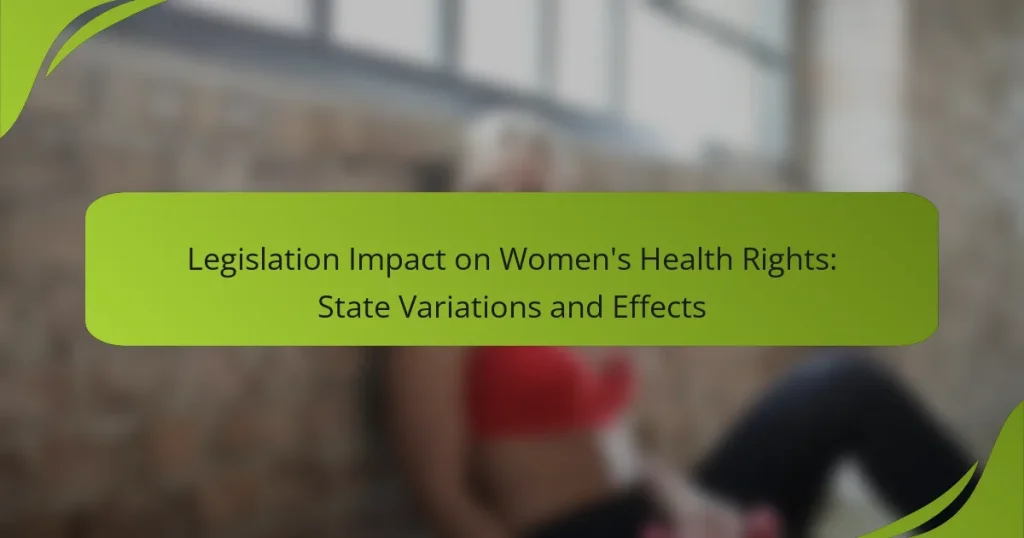Women’s health and rights initiatives in the United States are vital for promoting equitable access to healthcare and safeguarding reproductive rights. These efforts involve advocacy groups that raise awareness and influence policy to address gender-based health disparities. Despite facing challenges such as limited access and systemic discrimination, these initiatives strive to improve health outcomes for women across the nation.
Nonprofits in Women’s Health Advocacy: Roles, Impact and Collaboration
National vs. Local Advocacy Strategies: Effectiveness, Reach and Engagement
Successful Advocacy Campaigns: Strategies, Outcomes and Lessons Learned
Lobbying Efforts for Women’s Health Issues: Effectiveness, Strategies and Outcomes
Grassroots Movements for Women’s Health Initiatives: Strategies, Successes and Challenges
Legislation Impact on Women’s Health Rights: State Variations and Effects
What are the key women’s health and rights initiatives in the United States?
Key women’s health and rights initiatives in the United States focus on ensuring equitable access to healthcare, protecting reproductive rights, and addressing gender-based health disparities. These initiatives include legislation and policies aimed at improving women’s health outcomes and safeguarding their rights in various healthcare contexts.
Title IX and its impact on women’s health
Title IX is a federal law that prohibits sex-based discrimination in educational institutions receiving federal funding. Its impact on women’s health is significant, as it has led to increased access to sports and physical education for women, promoting better physical health and mental well-being.
By ensuring equal opportunities in athletics, Title IX has contributed to higher levels of physical activity among women, which is linked to reduced risks of chronic diseases. Educational institutions are required to provide resources and support for women’s health programs, further enhancing overall health outcomes.
Affordable Care Act provisions for women’s health
The Affordable Care Act (ACA) includes several provisions that specifically benefit women’s health, such as mandating coverage for preventive services without cost-sharing. This includes essential services like mammograms, cervical cancer screenings, and contraceptive services, which are crucial for early detection and reproductive health.
Additionally, the ACA expanded Medicaid eligibility in many states, allowing more low-income women to access healthcare services. This has been vital in reducing uninsured rates among women, particularly those from marginalized communities.
Women’s Health Protection Act overview
The Women’s Health Protection Act aims to safeguard access to abortion services across the United States by prohibiting restrictive state laws that limit reproductive rights. This legislation seeks to ensure that women can make personal healthcare decisions without unnecessary barriers.
By establishing a federal right to access abortion services, the Act addresses the growing number of state-level restrictions that disproportionately affect low-income women and women of color. Advocacy for this Act emphasizes the importance of maintaining reproductive healthcare as a fundamental right in the face of changing political landscapes.
How do advocacy groups influence women’s health policies?
Advocacy groups play a crucial role in shaping women’s health policies by raising awareness, mobilizing public support, and lobbying government officials. They work to ensure that women’s health issues are prioritized in legislative agendas and that policies reflect the needs and rights of women.
Role of Planned Parenthood in policy advocacy
Planned Parenthood is a leading organization in advocating for women’s health rights, particularly in reproductive health services. They engage in lobbying efforts, provide education on health issues, and mobilize grassroots campaigns to influence policy decisions at local, state, and national levels.
Through their extensive network, Planned Parenthood has successfully advocated for access to affordable contraceptives and safe abortion services, often facing significant political opposition. Their efforts have led to the establishment of protective laws and funding for women’s health programs.
Impact of the National Organization for Women
The National Organization for Women (NOW) focuses on a broad range of women’s rights issues, including health care access, reproductive rights, and workplace equality. By advocating for legislative changes and raising public awareness, NOW has been instrumental in advancing policies that benefit women’s health.
NOW’s campaigns often highlight disparities in health care access and push for comprehensive health care reform. Their advocacy efforts have contributed to significant policy changes, such as the expansion of Medicaid and the implementation of protections against gender discrimination in health care settings.
What are the challenges facing women’s health rights initiatives?
Women’s health rights initiatives face significant challenges, including limited access to essential services, inadequate funding, and systemic discrimination. These obstacles hinder the effectiveness of programs aimed at improving women’s health and well-being.
Access to reproductive health services
Access to reproductive health services is crucial for women’s autonomy and health. Many women encounter barriers such as geographical distance, lack of transportation, and insufficient local healthcare providers. In some regions, restrictive laws further limit access to necessary services, including contraception and safe abortion.
To improve access, initiatives can focus on expanding telehealth services, increasing the number of clinics in underserved areas, and advocating for policy changes that protect reproductive rights. Community outreach programs can also educate women about available services and their rights.
Funding disparities in women’s health programs
Funding disparities significantly impact the availability and quality of women’s health programs. Many initiatives receive less financial support compared to other health sectors, leading to inadequate resources for effective service delivery. This often results in fewer programs addressing critical issues such as maternal health, mental health, and preventive care.
To address funding disparities, advocates can push for increased government allocations and private sector partnerships. Additionally, raising awareness about the importance of women’s health can help mobilize community support and attract donations to sustain vital programs.
How can individuals support women’s health initiatives?
Individuals can support women’s health initiatives by actively participating in advocacy efforts and contributing financially to organizations dedicated to improving women’s health. These actions can significantly impact local and global health policies and resources.
Participating in local advocacy campaigns
Engaging in local advocacy campaigns allows individuals to raise awareness about women’s health issues and influence policy changes. This can include attending town hall meetings, joining community groups, or participating in rallies that focus on women’s health rights.
Consider volunteering with organizations that focus on women’s health, as they often need help with outreach and education efforts. By becoming an active member of these campaigns, you can help amplify the voices of those affected by health disparities.
Donating to women’s health organizations
Financial contributions to women’s health organizations can provide essential resources for programs that support health education, research, and access to care. Donations can range from small monthly contributions to larger one-time gifts, depending on your capacity.
When choosing an organization to support, research their impact and transparency. Look for groups that have a proven track record in advocating for women’s health rights and that allocate a significant portion of their funding directly to programs and services.
What are the global perspectives on women’s health rights?
Global perspectives on women’s health rights emphasize the need for equitable access to healthcare, reproductive rights, and protection from gender-based violence. These rights are recognized as fundamental human rights that contribute to the overall well-being of women and society.
Comparison of women’s health policies in Europe
Women’s health policies in Europe vary significantly by country, reflecting diverse cultural, economic, and political contexts. For instance, Scandinavian countries often provide comprehensive healthcare services, including reproductive health, with minimal out-of-pocket expenses. In contrast, some Eastern European nations may have limited access to certain services, leading to disparities in health outcomes.
Key elements of effective women’s health policies include universal access to healthcare, education on reproductive rights, and strong legal frameworks to protect against discrimination. Countries that prioritize these elements tend to see better health indicators among women.
Global initiatives by the World Health Organization
The World Health Organization (WHO) leads several global initiatives aimed at improving women’s health rights, focusing on areas like maternal health, family planning, and the prevention of gender-based violence. Programs such as the Global Strategy for Women’s, Children’s and Adolescents’ Health aim to ensure that all women have access to essential health services.
WHO also collaborates with member states to develop guidelines and policies that promote gender equality in health. These initiatives often include training healthcare providers, improving data collection on women’s health issues, and advocating for policies that support women’s rights at national and international levels.
What future trends are emerging in women’s health advocacy?
Emerging trends in women’s health advocacy focus on expanding access to services, prioritizing mental health, and recognizing the diverse needs of women. These trends aim to create a more inclusive and effective healthcare system that addresses the unique challenges faced by women today.
Telehealth expansion for women’s services
Telehealth is increasingly becoming a vital component of women’s health services, providing convenient access to care. This expansion allows women to consult healthcare providers from the comfort of their homes, which is particularly beneficial for those in rural areas or with mobility issues.
Healthcare providers are now offering a range of services through telehealth, including routine check-ups, mental health counseling, and reproductive health consultations. As telehealth technology continues to improve, it is essential for women to familiarize themselves with available platforms and ensure they have the necessary tools for effective virtual consultations.
Increased focus on mental health in women’s health policies
There is a growing recognition of the importance of mental health within women’s health advocacy. Policies are increasingly integrating mental health services into overall healthcare plans, acknowledging that mental well-being is crucial for physical health.
Advocates are pushing for comprehensive mental health coverage, including access to therapy and counseling services. Women should be aware of their rights regarding mental health care and seek support when needed, as early intervention can lead to better health outcomes.
Intersectionality in women’s health advocacy
Intersectionality is becoming a key principle in women’s health advocacy, recognizing that various factors such as race, socioeconomic status, and sexual orientation impact health outcomes. This approach aims to address the unique challenges faced by marginalized groups of women.
Advocates are working to ensure that health policies reflect the diverse experiences of women, promoting tailored solutions that consider these intersecting identities. Women should engage with advocacy groups that prioritize intersectional approaches to ensure their specific needs are addressed in health initiatives.






